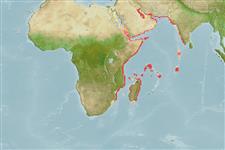Common names from other countries
Classification / Names / Names
आम नाम | उपशब्द | Catalog of Fishes (gen., sp.) | ITIS | CoL | WoRMS
Environment: milieu / climate zone / depth range / distribution range
पारिस्थितिकी
; गहराई सीमा 0 - 24 m (Ref. 107695). Tropical
Western Indian Ocean.
Length at first maturity / आकार / वज़न / Age
Maturity: Lm ? range ? - ? cm
Minimum depth from Ref. 1726. Intertidal to shallow subtidal. Found under medium-sized granite rocks or dead coral slabs, slightly buried in coarse sand (Ref. 1726). Most chitons are microphagous feeders that consume fine algae and other organisms they scrape via their radula (Ref. 833).
Life cycle and mating behavior
परिपक्व अवधि | पुनरुत्पत्ति | मछलीऔ का अंडे देना | अंडे | Fecundity | लार्वा
Members of the class Polyplacophora are mostly gonochoric. Life cycle: Eggs hatch into lecitotrophic planktonic trocophore larvae (no veliger stage) which later metamorphose and settle on the bottom as young adults.
Dell'Angelo, B., A. Bonfitto, M. Taviani and B. Sabelli. 2003. (Ref. 703)
IUCN Red List Status (Ref. 130435)
CITES status (Ref. 108899)
Not Evaluated
Not Evaluated
Threat to humans
Harmless
Human uses
| FishSource |
साधन
अधिक जानकारी
Age/Size
बाढ़
Length-weight
Length-length
आकृति विज्ञान
लार्वा
बहुतायत
इंटरनेट स्रोत
Estimates based on models
Preferred temperature
(Ref.
115969): 26.2 - 29, mean 27.5 (based on 543 cells).
Price category
Unknown.
